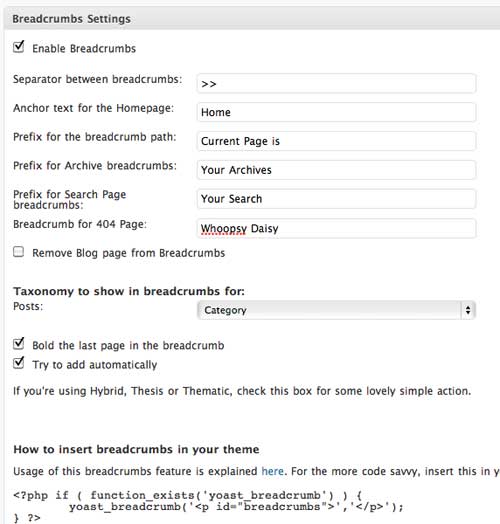After working with the All-in-One-SEO plugin for WordPress for a few years now, we’ve seen a new player enter the space in the form of WordPress developer/blogger/speaker Yoast who has released his WordPress SEO plugin. For those who follow Joost de Valk, you’ll be very aware that he has some very strong opinions but for the most part, he is able to back them up. His blog is well worth subscribing to if you have an interest in all things WordPress.
The features he states his plugin possesses includes the following:
Post titles and meta descriptions
Robots Meta configuration
Canonical
Breadcrumbs
Permalink clean up
XML Sitemaps
RSS enhancements
Edit your robots.txt and .htaccess
Clean up head section
All of these are very useful but none that can’t be performed manually or with a slew of other plugins. One of the many benefits it seems is that all these features can be controlled in the one convenient location. In addition, there are some very nice features that are pretty impressive and useful. So let me give you a few thoughts and a bit of an overview from my recent tinkering.
Install – like most WordPress plugins it’s an easy install and is bold enough to give itself pride of place as an admin tab.
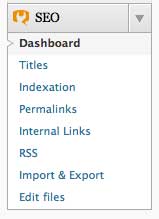
Moving our way from the top down, let’s start off with the Dashboard.
General Settings – these appear to pertain mostly to the WordPress admin elements so are truly dependent on your personal preference rather than SEO benefits. Of these options, I would choose the “Use meta keywords tag?” just to give me some additional control over this area (not that it necessarily contributes a great deal but it helps me to organize a page plus when SE’s decide to use them again as a factor in rankings, my clients will be all set up;) The option of disabling the Advanced part may also be a consideration, though it’s generally not a big distraction being tucked away neatly so feel free to leave that off. SO far it looks a little bit like this.
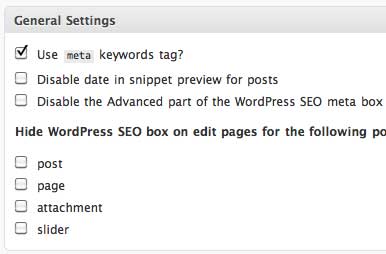
Webmaster Tools – obviously there are several methods for verifying a website. Bing webmasters is horrible but should be added. Google webmasters is a no-brainer. FYI put the full meta tag in, not just the numbers.
XML Sitemap – this is a nice addition to have incorporated into the plugin and unless you like the additional controls that some XML sitemap plugins or software offer, go ahead and check the box to enable. For this we want to go ahead and “Add images to XML sitemap”, Ping all of the Search Engines. As far as the exclusions go, there may be some reason for exclusions but I’ve never seen any reason to so feel free to leave them unchecked.
Titles – this is a pretty valuable SEO component so worth taking the time to fill it out appropriately. Depending on how your template is built, you may actually be limited here. Generally your title should look something like . If it doesn’t, you’re going to have to change it. Once that’s done, now we want to “Force rewrite titles” and start adding the title rules that you want the system to adopt. You’ll notice at the bottom of this particular page a “Help on Title Settings” option which may come in handy. The image below may also offer some assistance for you. We’re assuming you’ve done some keyword research here so I’ll just leave that assumption for now.
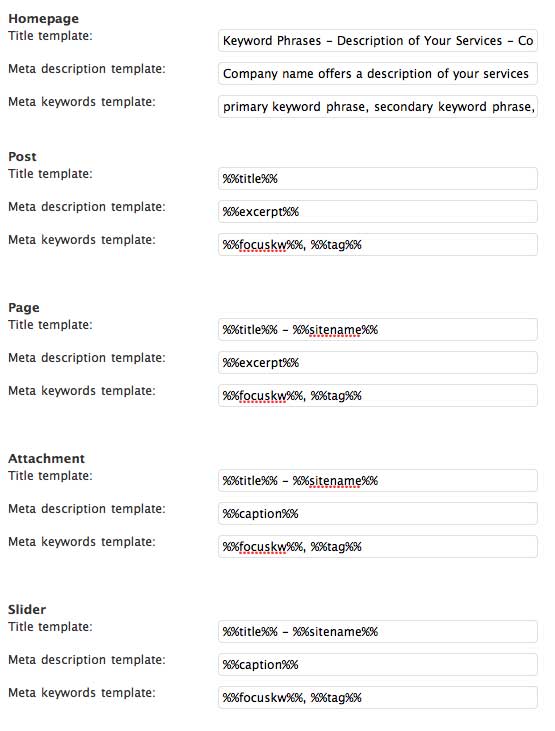
Taxonomies – pretty similar to the titles. Below should be the basic layout but I like to customize a little bit more. When doing so, try to be as descriptive as possible.
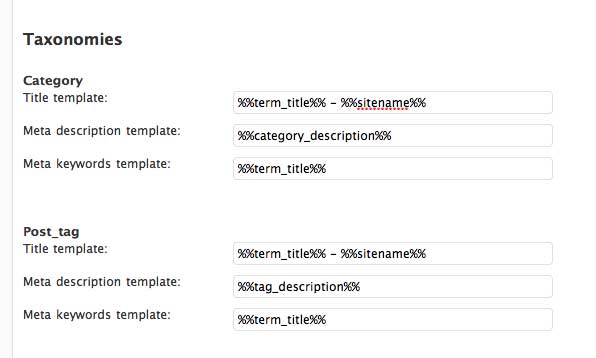
Indexation – gives you the opportunity to let search engines know which parts of your website you want to prevent them from crawling. You want to tread fairly lightly here to avoid preventing Search Engines from crawling areas you actually want them to crawl. See below for my preferred defaults.
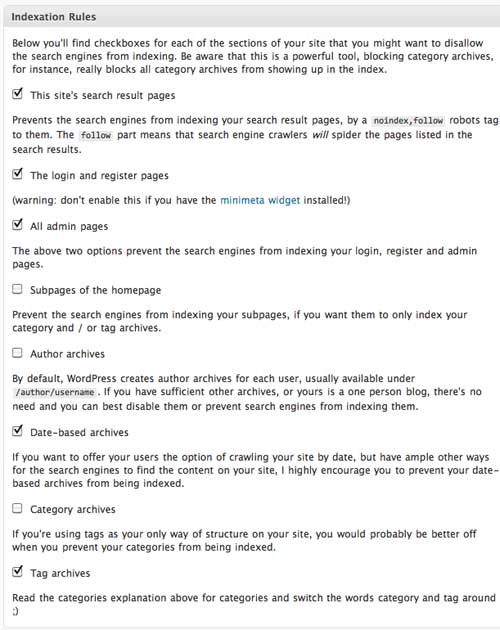
Internal nofollow settings – while I’ve never been a fan of the nofollow, there are times where it comes in handy. You’ll want to “nofollow login and registration links” at the very least.
Archive Settings – search engines appear to be smart enough to be able to figure out duplicate content issues in blogs but why not spell it out for them. I’d at least check the “Disable the author archives”
Robots Meta Settings – I’d take the advice set out in the introductory paragraph and leave these adjustments on a per post/page basis.
Clean up section – this section can get pretty bloated so many of us do indeed like to keep things nice and tidy. “Hide WordPress Generator”, Hide Index Relation Links” and “Hide Start Relation Links”.
Permalinks – from my best guess, this probably won’t let you control the actual permalink structure (which should be defined in the Settings area) but will allow for some additional controls. Again see below for what I would consider my go-to settings for this area.
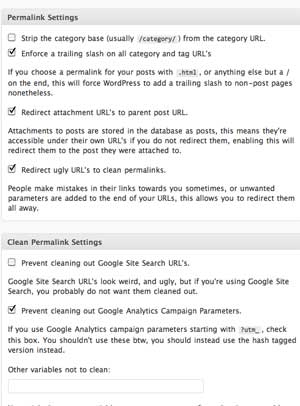
The Google Analytics Campaign parameters are a pretty common feature around the Web so I would definitely check this to ensure analytics accuracy. Joost has suggested the has tagged version which is OK if you have control over that but quite often you simply do not. So check it.
Internal Links – We always push for an internal linking structure that has a good flow to it. Breadcrumb trails really help search engines to make sense of a website and the WordPress SEO plugin has this additional capability built-in. There are some adjustments to be made to your WordPress template which can be a little on the tricky side.
RSS Settings – I don’t fully understand these features but will do a little research to figure them out but essentially for websites that don’t have feedburner, here is a way to ensure that your content gets out to the SE’s on every post.
Export Settings – a nice touch this one. This plugin requires a pretty decent amount of time to set up so you can make sure you can easily retrieve your settings if something happens or you can roll them over to other websites which should save a good chunk of time setting up. Very nice.
So these are some basic setup items for the new WordPress SEO plugin. Even though it’s a pretty lengthy install process, we have only recently started testing performance but I already have a feeling it’s well worth the effort.


